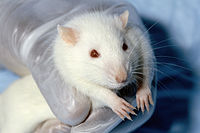
Photo from wikipedia
Humans are universally exposed to low levels of phthalate esters (phthalates), which are used to plasticize polyvinyl chloride. Phthalates exert adverse effects on the development of seminiferous cords in the… Click to show full abstract
Humans are universally exposed to low levels of phthalate esters (phthalates), which are used to plasticize polyvinyl chloride. Phthalates exert adverse effects on the development of seminiferous cords in the fetal testis through unknown toxicity pathways. To investigate the hypothesis that phthalates alter seminiferous cord development by disrupting retinoic acid (RA) signaling in the fetal testis, gestational day 15 fetal rat testes were exposed for 1-3 days to 10-6 M all-trans retinoic acid (ATRA) alone or in combination with 10-6-10-4 M mono-(2-ethylhexyl) phthalate (MEHP) in ex vivo culture. As previously reported, exogenous ATRA reduced seminiferous cord number. This effect was attenuated in a concentration-dependent fashion by MEHP co-exposure. ATRA and MEHP-exposed testes were depleted of DDX4-positive germ cells but not Sertoli cells. MEHP alone enhanced the expression of the RA receptor target Rbp1 and the ovary development-associated genes Wnt4 and Nr0b1, and suppressed expression of the Leydig cell marker, Star, and the germ cell markers, Ddx4 and Pou5f1. In co-exposures, MEHP predominantly enhanced the gene expression effects of ATRA, but the Wnt4 and Nr0b1 concentration-responses were nonlinear. Similarly, ATRA increased the number of cells expressing the granulosa cell marker FOXL2 in testis cultures, but this induction was attenuated by addition of MEHP. These results indicate that MEHP can both enhance and inhibit actions of ATRA during fetal testis development and provide evidence that RA signaling is a target for phthalate toxicity in the fetal testis.
Journal Title: Toxicological Sciences
Year Published: 2019
Link to full text (if available)
Share on Social Media: Sign Up to like & get
recommendations!